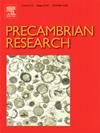吉尔吉斯斯坦Dzhetym群新元古代盖层灰岩管状微化石
IF 3.2
2区 地球科学
Q2 GEOSCIENCES, MULTIDISCIPLINARY
引用次数: 0
摘要
新元古代微化石记录为研究地球历史上一个动态时期海洋生物圈的演化和多样化提供了一个窗口。在新元古代的过程中,地球经历了两次全球冰期,随后是强烈的变暖间隔,大气中氧气的潜在上升,以及C、Si和Fe等地球化学循环的扰动。总的来说,与这些全球环境变化相一致的是,生物圈发生了关键的进化和生态变化,包括海洋真核藻类的增加,海洋生物圈多样性的增加,以及日益复杂的生物的出现。虽然广泛的进化趋势已被记录,但需要进一步研究来自全球各地的单个新元古代微化石组合,以更好地约束进化和生态变化,以及它们与不断变化的海洋环境的关系。在这里,我们提出了一个新的微化石组合,保存在吉尔吉斯斯坦Naryn地区Dzhetym群的黑色石灰岩中,直接覆盖在冰川二晶岩上。这些微化石是中空的管状结构,直径约25µm,由二氧化硅和铁组成。这些结构还含有干酪根,其化学性质与保存在石灰岩基质中的大块干酪根不同。根据其结构的组成和形态以及二氧化硅和铁对其的保存,我们认为它们代表了在碳酸盐为主的新元古代海洋环境中通过以前未被表征的埋藏学窗口保存的微化石。这些微化石的特征,以及促进其保存的埋藏机制,扩大了我们对新元古代海洋生物圈的理解,以及在冰川作用后促进微化石保存的潜在化学和生物过程。本文章由计算机程序翻译,如有差异,请以英文原文为准。
Tubular microfossils from Neoproterozoic cap limestone of the Dzhetym Group, Kyrgyzstan
The Neoproterozoic microfossil record provides a window into the evolution and diversification of the marine biosphere during a dynamic interval in Earth history. Over the course of the Neoproterozoic, the Earth experienced two global glaciations followed by intense warming intervals, a potential rise in atmospheric oxygen, and perturbations to the geochemical cycles of C, Si, and Fe, among others. Generally coincident with these global environmental changes, the biosphere saw key evolutionary and ecological changes that included a rise in marine eukaryotic algae, increased diversity of the marine biosphere, and the appearance of increasingly complex organisms. Although broad evolutionary trends have been documented, further investigation of individual Neoproterozoic microfossil assemblages from across the globe are needed to better constrain evolutionary and ecological changes and how they relate to changing marine environments.
Here, we present a new microfossil assemblage preserved in black limestone of the Dzhetym Group from the Naryn Region of Kyrgyzstan that directly overlie a glacial diamictite. These microfossils are hollow, tube-shaped structures of ∼25 µm in diameter composed of silica and iron. The structures also contain kerogen that is chemically distinct from the bulk kerogen preserved in the limestone matrix. Based on the composition and morphology of the structures and their preservation by silica and iron, we suggest that they represent microfossils preserved through a previously uncharacterized taphonomic window in a carbonate-dominated Neoproterozoic marine environment. Characterization of these microfossils, as well as the taphonomic mechanisms that facilitated their preservation, expands our understanding of the Neoproterozoic marine biosphere and the potential chemical and biological processes that facilitated microfossil preservation in the aftermath of a glaciation.
求助全文
通过发布文献求助,成功后即可免费获取论文全文。
去求助
来源期刊

Precambrian Research
地学-地球科学综合
CiteScore
7.20
自引率
28.90%
发文量
325
审稿时长
12 months
期刊介绍:
Precambrian Research publishes studies on all aspects of the early stages of the composition, structure and evolution of the Earth and its planetary neighbours. With a focus on process-oriented and comparative studies, it covers, but is not restricted to, subjects such as:
(1) Chemical, biological, biochemical and cosmochemical evolution; the origin of life; the evolution of the oceans and atmosphere; the early fossil record; palaeobiology;
(2) Geochronology and isotope and elemental geochemistry;
(3) Precambrian mineral deposits;
(4) Geophysical aspects of the early Earth and Precambrian terrains;
(5) Nature, formation and evolution of the Precambrian lithosphere and mantle including magmatic, depositional, metamorphic and tectonic processes.
In addition, the editors particularly welcome integrated process-oriented studies that involve a combination of the above fields and comparative studies that demonstrate the effect of Precambrian evolution on Phanerozoic earth system processes.
Regional and localised studies of Precambrian phenomena are considered appropriate only when the detail and quality allow illustration of a wider process, or when significant gaps in basic knowledge of a particular area can be filled.
 求助内容:
求助内容: 应助结果提醒方式:
应助结果提醒方式:


